
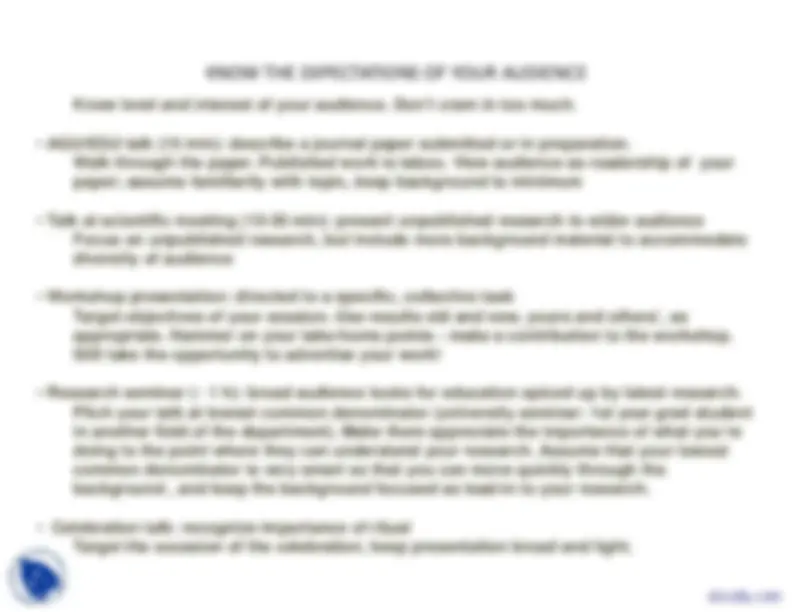
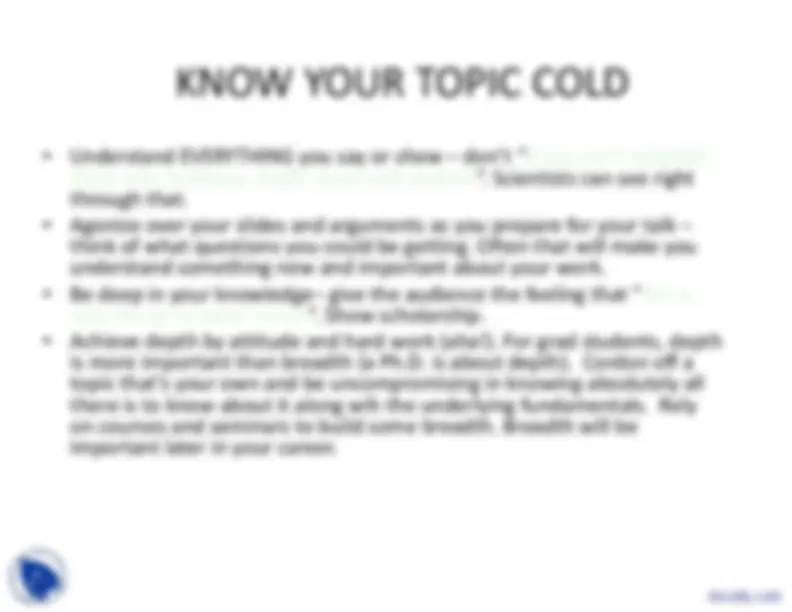
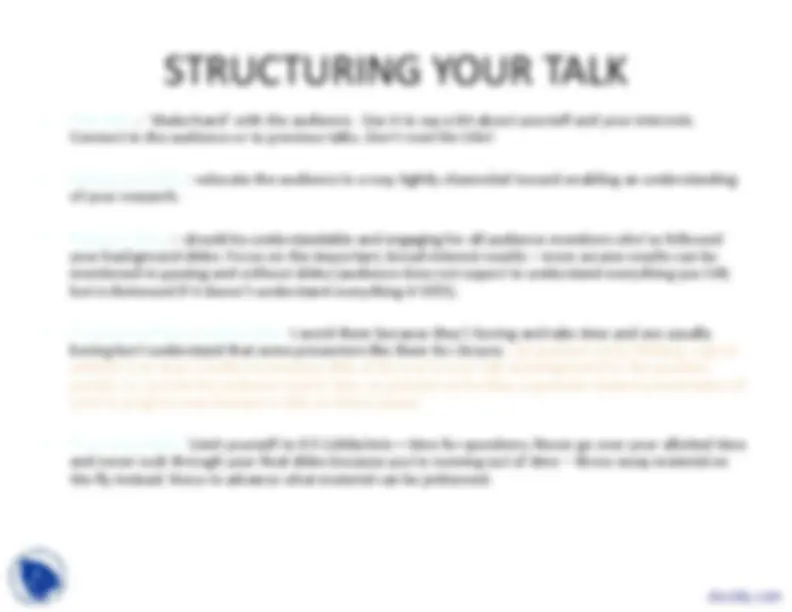
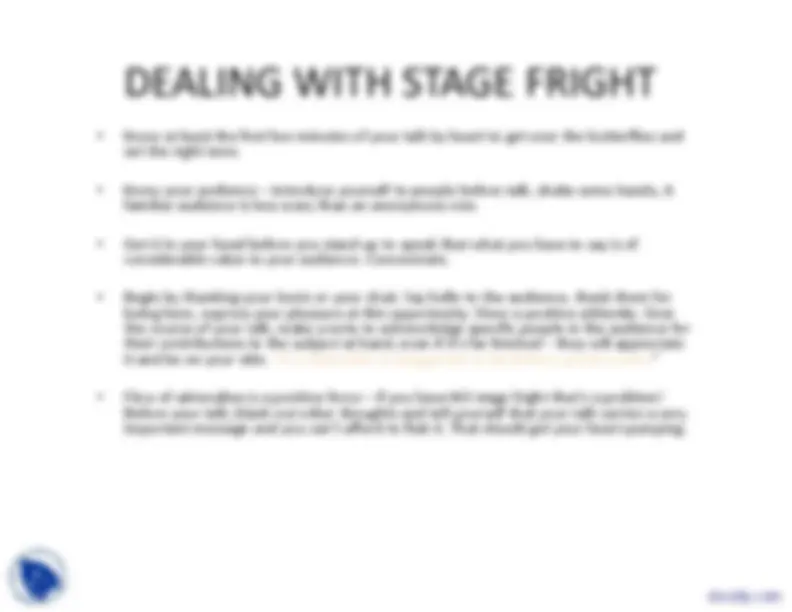
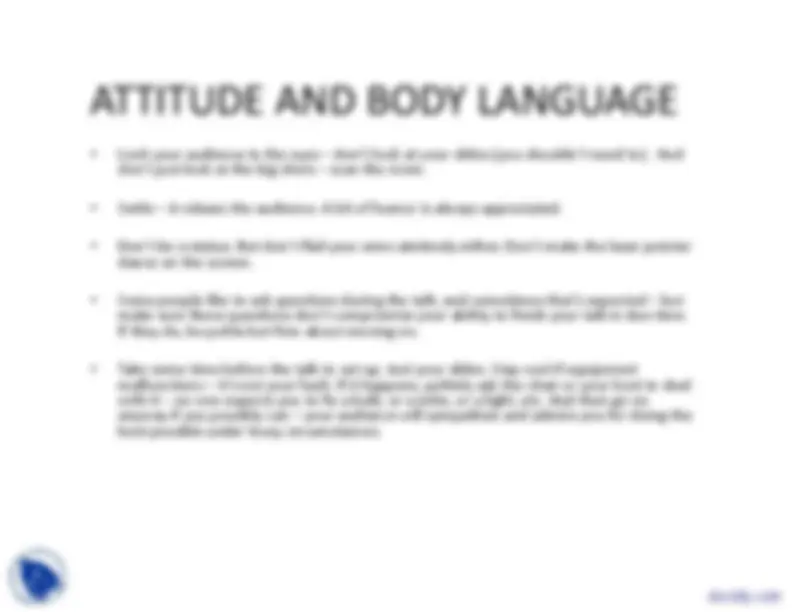
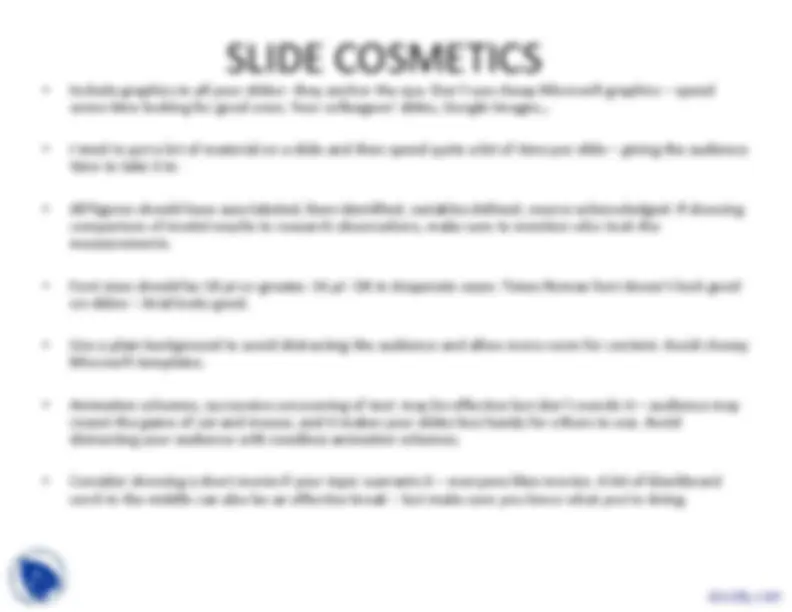


Study with the several resources on Docsity

Earn points by helping other students or get them with a premium plan


Prepare for your exams
Study with the several resources on Docsity

Earn points to download
Earn points by helping other students or get them with a premium plan
Community
Ask the community for help and clear up your study doubts
Discover the best universities in your country according to Docsity users
Free resources
Download our free guides on studying techniques, anxiety management strategies, and thesis advice from Docsity tutors
Project presentation is always tricky part in prject work. It can fail you even if you have done great work. Here are some very useful tips one can use in his presentation. How to Give an Effective Presentation, Denominator, Know Your Topic Cold, Structuring Your Talk, Title Slide, Future Plans Slides, Background Slides, Research Slides, Dealing With Stage Fright, Attitude and Body Language
Typology: Slides
1 / 12

This page cannot be seen from the preview
Don't miss anything!







Understand EVERYTHING you say or show
don’t “if you can’t befuddle them with brilliance, baffle them with bullshit”. Scientists can see right through that. - Agonize over your slides and arguments as you prepare for your talk - think of what questions you could be getting. Often that will make you understand something new and important about your work. - Be deep in your knowledge– give the audience the feeling that “ this is only the tip of what I know ”. Show scholarship. - Achieve depth by attitude and hard work (aha!). For grad students, depth is more important than breadth (a Ph.D. is about depth). Cordon off a topic that’s your own and be uncompromising in knowing absolutely all there is to know about it along wih the underlying fundamentals. Rely on courses and seminars to build some breadth. Breadth will be important later in your career.
Title slide
‘shake ‐hand’ with the audience. Use it to say a bit about yourself and your interests. Connect to the audience or to previous talks. Don’t read the title!
Background slides –educate the audience in a way tightly channeled toward enabling an understanding of your research. - Research slides
should be understandable and engaging for all audience members who’ve followed your background slides. Focus on the important, broad ‐interest results
more arcane results can be mentioned in passing and without slides (audience does not expect to understand everything you
but is distressed if it doesn’t understand everything it
Conclusions
future plans slides:
avoid them because they’r boring and take time and are usually boring but
understand that some presenters like them for closure. (as pointed out by Shiliang, a good solution is to show a bullet conclusions slide at the end of your talk as background for the question period, i.e., just let the audience read it. Also, as pointed out by May, a graduate student presentation of work in progress may demand a slide on future plans)
How many slides? Limit yourself to
‐1slide/min
time for questions. Never go over your allotted time and never rush through your final slides because you’re running out of time
throw away material on the fly instead. Know in advance what material can be jettisoned. docsity.com
As pointed out by Monika, equation slides can be very effective and there’snothing wrong with them – in fact they can be viewed as a graphic. But you thenhave to be painstaking in identifying all the variables and all the terms, and makethe equations look as simple, physical, and demystified as possible.
Know at least the first few minutes of your talk by heart to get over the butterflies and set the right tone.
Know your audience
introduce yourself to people before talk, shake some hands,
familiar audience is less scary than an anonymous one.
Get it in your head before you stand up to speak that what you have to say is of considerable value to your audience. Concentrate. - Begin by thanking your hosts or your chair. Say hello to the audience, thank them for being here, express your pleasure at this opportunity. Show a positive attitutde. Over the course of your talk, make a note to acknowledge specific people in the audience for their contributions to the subject at hand, even if it’s far ‐fetched
they will appreciate it and be on your side.
It is impossible to exaggerate in the flattery of one’s peers”
Flow of adrenaline is a positive force
if you have
stage fright that’s a problem! Before your talk, blank out other thoughts and tell yourself that your talk carries a very important message and you can’t afford to flub it. That should get your heart pumping.
Include graphics in all your slides– they anchor the eye. Don’t use cheap Microsoft graphics
spend some time looking for good ones. Your colleagues’ slides, Google Images…
tend to put a lot of material on a slide and then spend quite a bit of time per slide
giving the audience time to take it in.
All figures should have axes labeled, lines identified, variables defined, source acknowledged. If showing comparison of model results to research observations, make sure to mention who took the measurements. - Font sizes should be
pt or greater.
pt
in desperate cases. Times Roman font doesn’t look good on slides
Arial looks good.
Use a plain background to avoid distracting the audience and allow more room for content. Avoid cheesy Microsoft templates. - Animation schemes, successive uncovering of text may be effective but don’t overdo it
audience may resent the game of cat and mouse, and it makes your slides less handy for others to use. Avoid distracting your audience with needless animation schemes.
Consider showing a short movie if your topic warrants it
everyone likes movies.
bit of blackboard work in the middle can also be an effective break
but make sure you know what you’re doing. docsity.com